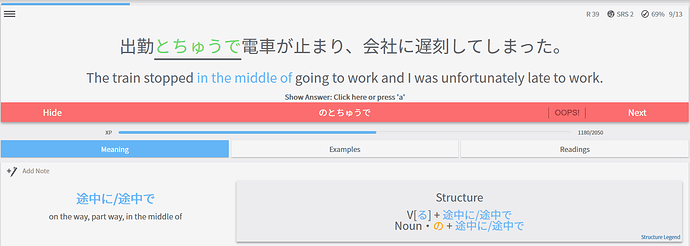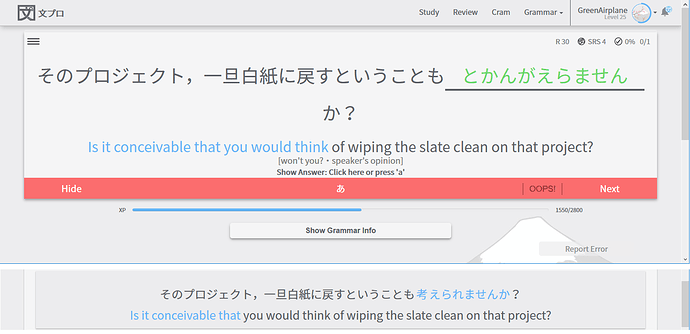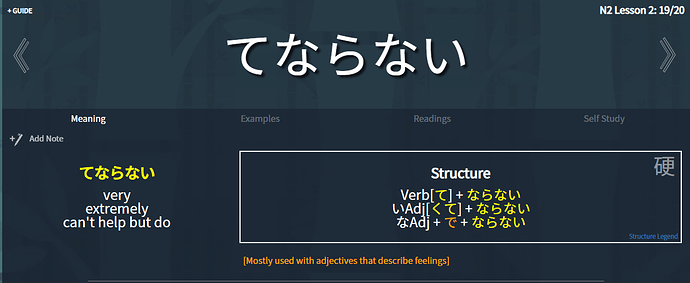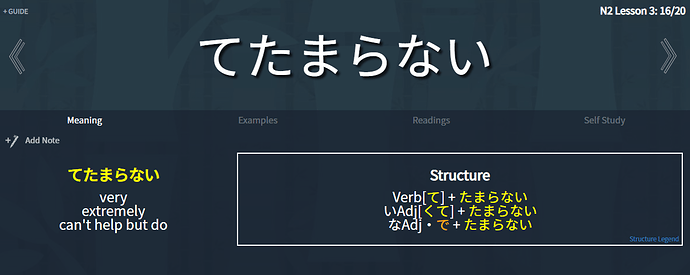If どころではなくなった is the correct answer, shouldn’t どころじゃなくなった also be accepted? After all, the どころではない reviews also accept どころじゃない.
For this grammar point you state that if you use とちゅうで with nouns, you need to use the の particle. All your example sentences comply to this, except the one in the screenshot.
I retook the JCAT and scored 20 points more on the grammar section than I did when I took it in September. Thanks BunPro! 
Was going through a Japanese Ammo video and found this: https://youtu.be/kDmdYQ33cCw?t=1278 Not sure if you wanna add that time code to this grammar point: https://bunpro.jp/grammar_points/296 But figured I’d post jic 
So I’m not convinced the WaniKani ‘hide furigana’ thing is working. My API key is definitely correct, but Bunpro is showing me the furigana for kanji I definitely know. Is anyone else experiencing this?
@MonklyStitch Thank you for your feedback! It looks like this issue was related to another that we have fixed. Please let us know if you continue to see furigana for kanji that should not be displayed. Cheers!
Edit: Looks like this issue still persists. We hope to have a fix for you soon. Thank you for your patience. Cheers!
The grammar search is extremely slow recently. On Android it takes more than 20s to load the grammar search (until the Android keyboard shows up for search input). That’s too much.
Could you maybe just place a search field into the right 3-dot-menu, so that a search term can be entered there and after pressing submit it will open the grammar search to look for that term? This would save the time that is needed to open the grammar search with all grammar points. Also Android users wouldn’t need to wait 20s until the keyboard shows up.
I’d also like to be able to search without opening up a separate search page first.
We need a way to edit or change the English translations of the example sentences. Things are always lost in translation and that’s unavoidable, but many of the details lost in translation make it difficult to understand which grammar point is being indicated. This could be easily resolved if we could make our own changes.
Hey 
At the moment it is not possible, but
if you have an idea for better translation you can always PM or @ me 

I just finished my reviews and it said it complete reset them as if I never did them. I did them twice now and it still thinks I havnt done my reviews.
@jakefromstatefarm We apologize for the inconvenience. This issue should be resolved. Please let us know if you continue to experience any problems. Cheers!
[edit: forgot to attach the screensot :D]
In this answer you’re missing a「れ」and the 「と」at the beginning doesn’t seem to fit there. Also, could you add the plain form as alternative answer?
While I’m at it, I’d like to ask the same of the grammar points だけに and だけあって
Hey 
Yes, they have the same meaning. Though てならない is usually limited to verbs/adjectives that describe feelings.
てたまらない doesn’t have that limitation and is used not only for feelings but also for physiological needs like wanting to pee, being thirsty.
おしっこしたくてならない。X
おしっこしたくてたまらない。 ✓
I REALLY want to pee.
So basically you can always rephrase てならない to てたまらない but not the other way around.
だけに vs だけあって
They are also very similar BUT there are two important differences.
だけあって unlike だけに cannot be used with negative phrases (by that I mean more of not desirable things rather than word negation) and to say “on the contrary to A”.
So だけあって is only used to say positive/nice things about someone/ something.
This difference sometimes appears on JLPT A B C D questions when you have a negative sentence and have to choose between だけに and だけあって. It is a tricky question. The answer is だけに.
So, again you can always rephrase だけあって to だけに but not always the other way around.
Hey 
Thank you for notifying us!
All fixed 


 You rock!
You rock!

